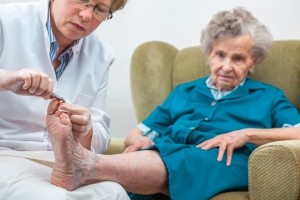Elderly diabetic patients are particularly burdened by foot disease. The main causes for foot disease are peripheral neuropathy, foot deformities and peripheral arterial disease (PAD). Other risk factors include poor vision, gait abnormalities, reduced mobility an medical co-morbidities.
When you have diabetic peripheral neuropathy your feet and skin need extra care and attention. Very small, repetitive injuries to the feet - like those caused by poorly fitting shoes - can lead to bigger problems. Calluses, blisters, sores, infections, and foot ulcers may appear on numb areas of the foot because pressure or injury goes unnoticed. This happens simply because you can't feel the problem.
Also, people with uncontrolled diabetes have a hard time fighting infections. They may also have poor circulation that can lead to problems with healing. That means a minor cut in your skin could become an ulcer or develop into a serious infection. With good foot care, you can prevent most of these problems.
Importance of Proper Foot Care for the Elderly with Diabetes
It's recommend that the elderly inspect their feet on a daily basis for cuts, any signs of redness, calluses, or blisters," says Elasy. "Using a little mirror can help. Also, it's important to moisturize but avoid getting it between the toes because that area is already moist. Extra moisture tends to cause fungal infections.
It's best to do it when you are bathing or getting ready for bed. And remember that good foot care also involves getting medical help early if a problem develops. It's very important to see your doctor for treatment right away - to prevent serious complications like infections.
Here are good everyday habits to follow:
-
Inspect your feet daily. Wash your feet, and then thoroughly dry them. Use a handheld mirror (like a magnifying mirror) to inspect them. Look for blisters, cuts, cracks, dry skin, redness, tenderness, or sores on the skin and on the soles of your feet.
-
Powder in between your toes. This helps keep that moist skin dry and helps prevent fungal infections.
-
Rub lotion on your feet and legs to prevent dry cracked skin. But don't put lotion between your toes because of the risk of fungal infections.
-
Keep your nails trimmed. Use an emery board for filing so you don't hurt your skin.
-
Protect your feet. Always wear shoes or slippers to protect your feet from injury. Don't use a heating pad or hot water bottle to warm your feet.
-
Get checkups at the doctor. On each visit, make sure your doctor inspects your feet.
-
Don't use corn removers or other drugstore foot treatments. These can be harmful. Let your doctor treat your foot problems.
-
Wear properly fitted shoes. Also, wear socks at all times to prevent injury.
-
Avoid Smoking. And here's yet another reason to avoid tobacco: Smoking narrows the arteries and can hamper blood flow.
Another way for the elderly to protect their feet is to keep their blood flowing freely. If you usually spend much of the day in a chair, you can improve your circulation by stretching, walking, and other exercises. Avoid wearing tight socks or sitting too long with your legs crossed.
Related Articles:
- Seniors Living and Diabetes: What Medicare Pays For
- Online Diabetes Risk Test
- The Connection Between Heart Disease and Diabetes
Home | About | Articles | Resources | Site Map | Privacy Policy
Elder Options of Texas
Copyright 2001-2024
All Rights Reserved
DISCLAIMER: Links to other websites or references to products, services or publications do not imply the endorsement or approval of such websites, products, services or publications by Elder Options of Texas. The determination of the need for senior care services and the choice of a facility is an extremely important decision. Please make your own independent investigation.



